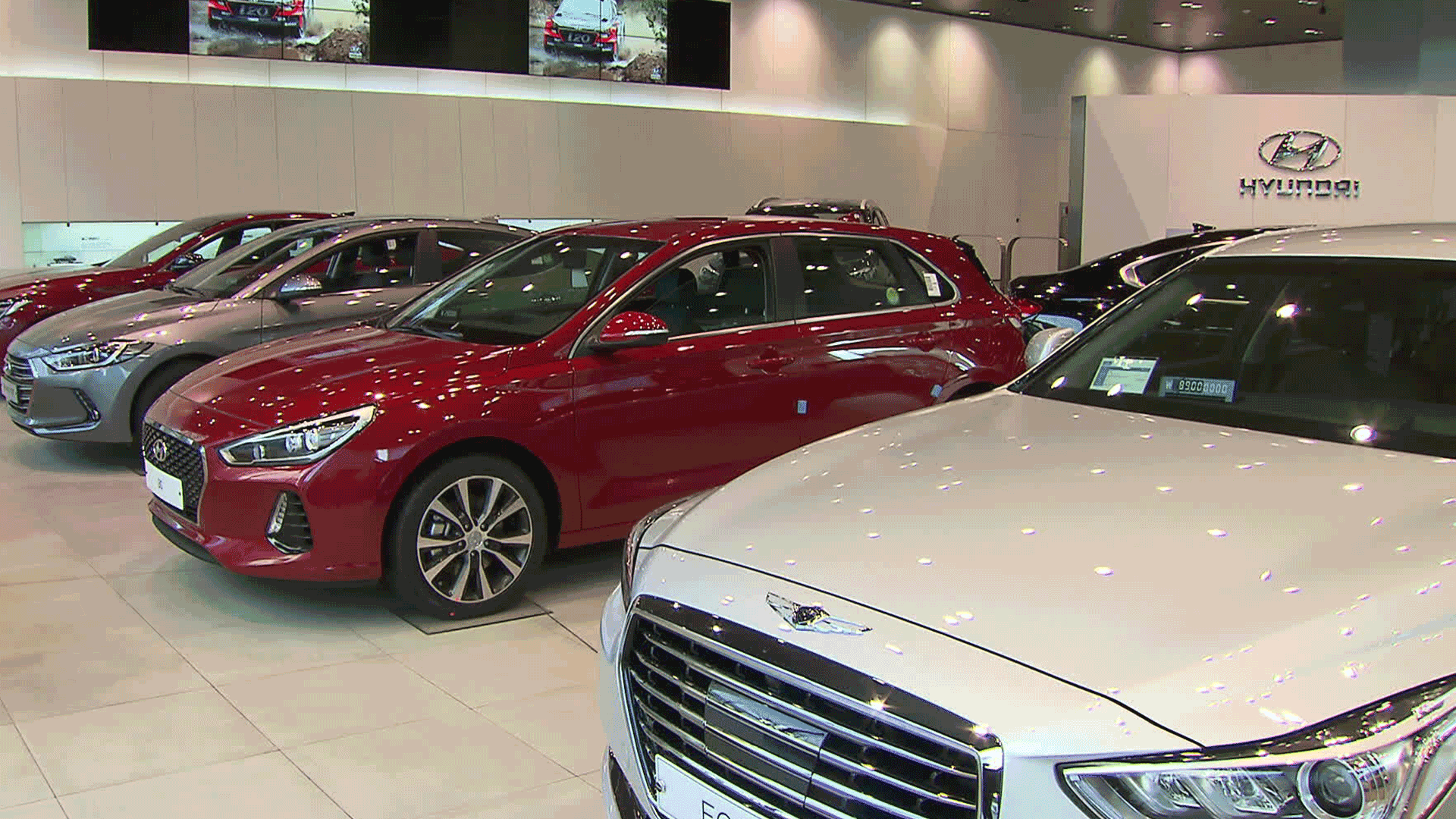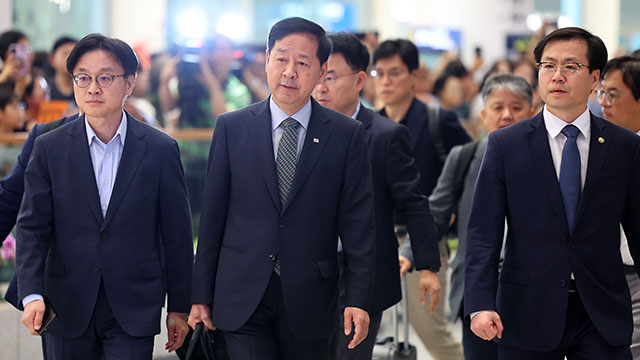[Anchor]
The automotive tariff, which garnered the most attention, has been set at 15%, the same as reciprocal tariffs.
While this is at the same level as competitors like Japan and Europe, considering that we originally had an advantage due to the Korea-U.S. FTA, it can be seen as a disadvantage.
Reporter Park Kyung-jun has more.
[Report]
The item that the negotiation team focused on the most is automobiles, which had a 25% tariff imposed in April.
Last year, the export amount was $34.7 billion, making it the top export item to the U.S. by share.
The automotive tariff agreed upon by Japan and the European Union is 15%.
This figure is derived from halving the previous 25% item-specific tariff and adding the existing 2.5% tariff that was in place before the Trump administration.
On the other hand, we have lost the 0% tariff we enjoyed under the Korea-U.S. FTA and are now subject to the same 15% tariff as our competitors.
President Trump, concerned about domestic backlash, insisted on the 15% until the end, and the negotiation team stated that they had to accept it as they could no longer delay.
[Kim Yong-beom/Head of Policy Office at the Presidential Office: "It's a disappointing part. We argued for 12.5% as best as we could, but that was as far as we could go..."]
The $1,250 price advantage that Korea had when selling the same $50,000 car in the U.S. has now disappeared, and the burden has fallen on the companies.
The market reactions in Korea and Japan were starkly different.
On the day the tariff negotiations were concluded, Toyota's stock rose by 14%, while Hyundai's dropped by over 4%.
[Kim Kyung-yu/Senior Researcher at the Korea Institute for Industrial Economics and Trade: "To lower the increased costs compared to other competitors, we need to invest a lot in areas like smart manufacturing, and our government may also need to provide support..."]
Compared to large corporations that have the technology and capital to endure, the automotive parts industry is expected to face greater difficulties.
Most of them are small and medium-sized enterprises, raising concerns about a chain reaction of sales declines and employment slowdowns due to production contraction.
The tariff rates on steel, aluminum, and copper have been maintained at 50%.
This is KBS News, Park Kyung-jun.
The automotive tariff, which garnered the most attention, has been set at 15%, the same as reciprocal tariffs.
While this is at the same level as competitors like Japan and Europe, considering that we originally had an advantage due to the Korea-U.S. FTA, it can be seen as a disadvantage.
Reporter Park Kyung-jun has more.
[Report]
The item that the negotiation team focused on the most is automobiles, which had a 25% tariff imposed in April.
Last year, the export amount was $34.7 billion, making it the top export item to the U.S. by share.
The automotive tariff agreed upon by Japan and the European Union is 15%.
This figure is derived from halving the previous 25% item-specific tariff and adding the existing 2.5% tariff that was in place before the Trump administration.
On the other hand, we have lost the 0% tariff we enjoyed under the Korea-U.S. FTA and are now subject to the same 15% tariff as our competitors.
President Trump, concerned about domestic backlash, insisted on the 15% until the end, and the negotiation team stated that they had to accept it as they could no longer delay.
[Kim Yong-beom/Head of Policy Office at the Presidential Office: "It's a disappointing part. We argued for 12.5% as best as we could, but that was as far as we could go..."]
The $1,250 price advantage that Korea had when selling the same $50,000 car in the U.S. has now disappeared, and the burden has fallen on the companies.
The market reactions in Korea and Japan were starkly different.
On the day the tariff negotiations were concluded, Toyota's stock rose by 14%, while Hyundai's dropped by over 4%.
[Kim Kyung-yu/Senior Researcher at the Korea Institute for Industrial Economics and Trade: "To lower the increased costs compared to other competitors, we need to invest a lot in areas like smart manufacturing, and our government may also need to provide support..."]
Compared to large corporations that have the technology and capital to endure, the automotive parts industry is expected to face greater difficulties.
Most of them are small and medium-sized enterprises, raising concerns about a chain reaction of sales declines and employment slowdowns due to production contraction.
The tariff rates on steel, aluminum, and copper have been maintained at 50%.
This is KBS News, Park Kyung-jun.
■ 제보하기
▷ 카카오톡 : 'KBS제보' 검색, 채널 추가
▷ 전화 : 02-781-1234, 4444
▷ 이메일 : kbs1234@kbs.co.kr
▷ 유튜브, 네이버, 카카오에서도 KBS뉴스를 구독해주세요!
- Auto tariff stays at 15%
-
- 입력 2025-07-31 23:41:57

[Anchor]
The automotive tariff, which garnered the most attention, has been set at 15%, the same as reciprocal tariffs.
While this is at the same level as competitors like Japan and Europe, considering that we originally had an advantage due to the Korea-U.S. FTA, it can be seen as a disadvantage.
Reporter Park Kyung-jun has more.
[Report]
The item that the negotiation team focused on the most is automobiles, which had a 25% tariff imposed in April.
Last year, the export amount was $34.7 billion, making it the top export item to the U.S. by share.
The automotive tariff agreed upon by Japan and the European Union is 15%.
This figure is derived from halving the previous 25% item-specific tariff and adding the existing 2.5% tariff that was in place before the Trump administration.
On the other hand, we have lost the 0% tariff we enjoyed under the Korea-U.S. FTA and are now subject to the same 15% tariff as our competitors.
President Trump, concerned about domestic backlash, insisted on the 15% until the end, and the negotiation team stated that they had to accept it as they could no longer delay.
[Kim Yong-beom/Head of Policy Office at the Presidential Office: "It's a disappointing part. We argued for 12.5% as best as we could, but that was as far as we could go..."]
The $1,250 price advantage that Korea had when selling the same $50,000 car in the U.S. has now disappeared, and the burden has fallen on the companies.
The market reactions in Korea and Japan were starkly different.
On the day the tariff negotiations were concluded, Toyota's stock rose by 14%, while Hyundai's dropped by over 4%.
[Kim Kyung-yu/Senior Researcher at the Korea Institute for Industrial Economics and Trade: "To lower the increased costs compared to other competitors, we need to invest a lot in areas like smart manufacturing, and our government may also need to provide support..."]
Compared to large corporations that have the technology and capital to endure, the automotive parts industry is expected to face greater difficulties.
Most of them are small and medium-sized enterprises, raising concerns about a chain reaction of sales declines and employment slowdowns due to production contraction.
The tariff rates on steel, aluminum, and copper have been maintained at 50%.
This is KBS News, Park Kyung-jun.
The automotive tariff, which garnered the most attention, has been set at 15%, the same as reciprocal tariffs.
While this is at the same level as competitors like Japan and Europe, considering that we originally had an advantage due to the Korea-U.S. FTA, it can be seen as a disadvantage.
Reporter Park Kyung-jun has more.
[Report]
The item that the negotiation team focused on the most is automobiles, which had a 25% tariff imposed in April.
Last year, the export amount was $34.7 billion, making it the top export item to the U.S. by share.
The automotive tariff agreed upon by Japan and the European Union is 15%.
This figure is derived from halving the previous 25% item-specific tariff and adding the existing 2.5% tariff that was in place before the Trump administration.
On the other hand, we have lost the 0% tariff we enjoyed under the Korea-U.S. FTA and are now subject to the same 15% tariff as our competitors.
President Trump, concerned about domestic backlash, insisted on the 15% until the end, and the negotiation team stated that they had to accept it as they could no longer delay.
[Kim Yong-beom/Head of Policy Office at the Presidential Office: "It's a disappointing part. We argued for 12.5% as best as we could, but that was as far as we could go..."]
The $1,250 price advantage that Korea had when selling the same $50,000 car in the U.S. has now disappeared, and the burden has fallen on the companies.
The market reactions in Korea and Japan were starkly different.
On the day the tariff negotiations were concluded, Toyota's stock rose by 14%, while Hyundai's dropped by over 4%.
[Kim Kyung-yu/Senior Researcher at the Korea Institute for Industrial Economics and Trade: "To lower the increased costs compared to other competitors, we need to invest a lot in areas like smart manufacturing, and our government may also need to provide support..."]
Compared to large corporations that have the technology and capital to endure, the automotive parts industry is expected to face greater difficulties.
Most of them are small and medium-sized enterprises, raising concerns about a chain reaction of sales declines and employment slowdowns due to production contraction.
The tariff rates on steel, aluminum, and copper have been maintained at 50%.
This is KBS News, Park Kyung-jun.
-
-

박경준 기자 kjpark@kbs.co.kr
박경준 기자의 기사 모음
-
이 기사가 좋으셨다면
-
좋아요
0
-
응원해요
0
-
후속 원해요
0















이 기사에 대한 의견을 남겨주세요.